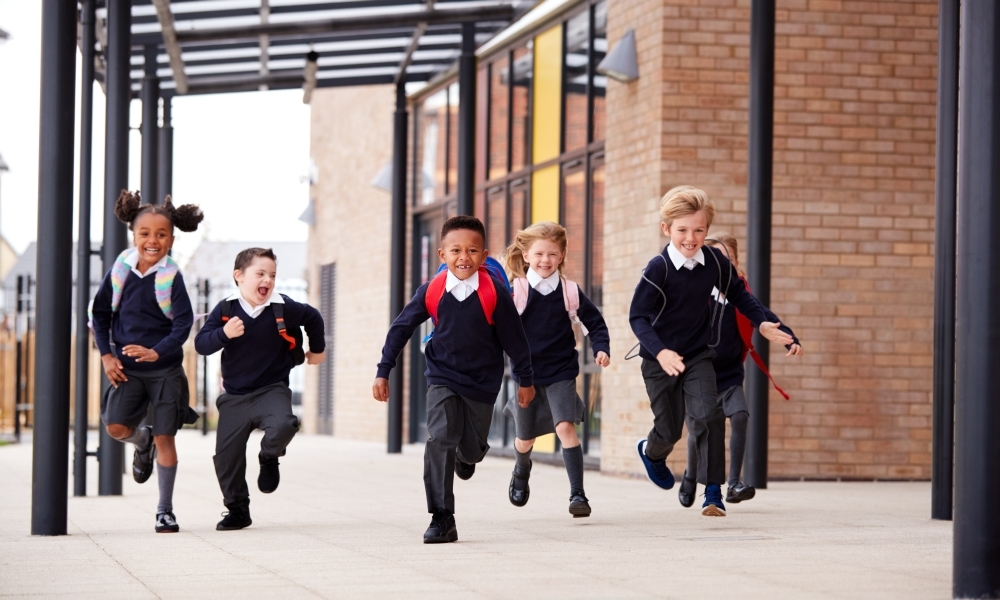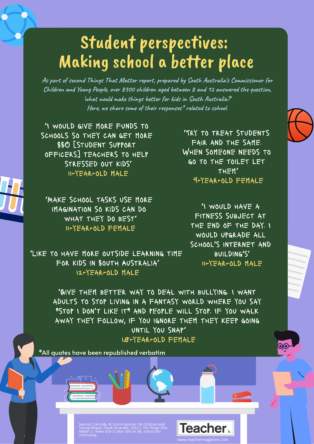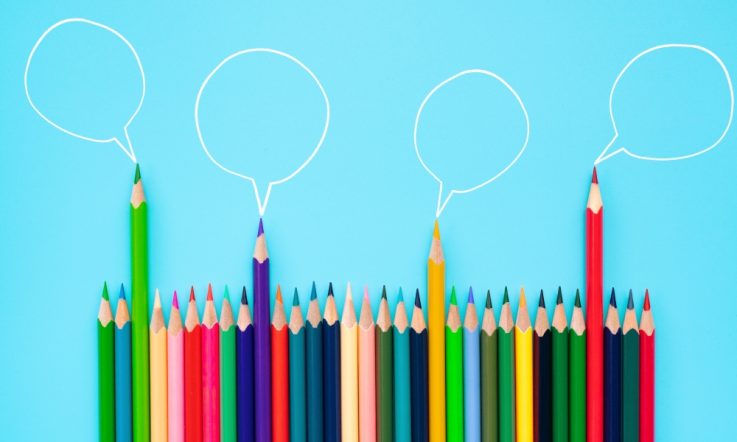In this Q&A, Teacher Editor Jo Earp speaks to Helen Connolly, South Australian Commissioner for Children and Young People. The Commissioner’s Student Voice Postcard initiative collects responses from more than 13,000 primary school students across the state on what’s important to them, their aspirations, worries and what they would change if they could. Our infographic takes a look at some of their 2021 responses related to school.
The Commissioner has just released The Things That Matter 3 report this week. Here, she shares more details about the project, the results and how teachers can get their students involved in the latest collection cycle.
When did you start the postcards project and why did you bring it in?
Children between the ages of 8 and 12 years are rarely given an opportunity to have their voices heard at a time in their lives when they have such unique insight into school, friendships, family and community life that should be captured. I wanted a simple and scalable way to gather data from them, whilst at the same time letting them know that I am here to advocate on their behalf on the things that matter to them.
The postcard idea seemed like an age-appropriate and fun way to gather primary source data from a diversity of children and easy tool for educators to implement that, over time, will show us what is happening in children’s lives.
I couldn’t have anticipated just how interesting the responses would be. We are now entering our fourth year of the initiative and have received close to 30,000 postcards since it began in 2019. I’ve produced 3 reports and a number of snapshots that provide readers with a deep insight into what matters most to children in this age group, and what we can do as adults to ensure their lives are fulfilling and supportive, enabling them to realise their potential and determine their choices based on what their interests and passions are.
How does the project work?
Each primary campus throughout South Australia is sent a Student Postcard Pack at the start of Term 3 each year. The packs contain a set of instructions for teachers and a set of blank postcards for distribution to their students. The postcards contain 4 key questions that students are invited to answer and there is room to include an illustration if they have time or would like to contribute one.
The initiative aligns with student voice and agency aspects of the curriculum and I emphasise that the responses need to come from the students themselves with gentle encouragement from educators.
Why is it important to you that students have a say on education matters in this way?
Children and young people are passionate about their education and what the future can give them. They are also aware that they need educators and government to look out for them as they navigate their way through.
Unsurprisingly, the things that are important to them are consistent with the rights and responsibilities stated in the UN Conventions on the Rights of the Child (CRC). If we want to ensure education is accessible, equitable, and inclusive, and a better place for students and teachers, then we must include the voices of children and young people into the mix to understand what is and isn’t working for them.
Children are the experts in their own lives, and they know what they want and need more than we ever could. It is not enough for us to simply assume we know what their needs are. We must seek their input and guidance so we can co-design services that will best meet their needs.
What themes stood out for you from the latest set of results?
Children are deeply concerned about the environment. They see the impact it is having on their community and they want to be sure that there will be a future for them to enjoy.
They’re concerned that adults don’t listen to them and don’t think they’re as clever as they actually are. Adults also tend to be dismissive of their ideas and insights and think they know best. But children are telling me that they have many ideas on how things could be improved if only adults would listen.
They have some great ideas on education reform too. These include expanding curriculums to include learning life skills earlier and addressing issues of inequity and cost barriers for those who are struggling or less fortunate.
They’re also tired of being affected by COVID-19, which has kept them apart from the people they love and the activities and experiences that bring them joy and connection with others.
There's so much rich information that’s gathered – how long does it take to collate and what happens to it then?
The postcards come back to us by the end of Term 4 and we spend the summer months examining the responses and analysing before writing up our report. This includes determining the differences between regional and metropolitan communities which, although similar, do show some differences.
The reports are sent to key decision makers, policymakers, government and community leaders as well as to other influencers, whom I also meet with where possible, to discuss ways in which children’s voices can be incorporated into the services adults plan and deliver to them.
Do you have any plans to extend the project, or introduce something similar for students in secondary schools?
Secondary schools are a different kettle of fish. We meet with them regularly in smaller groups on particular subjects and they have opportunities that primary school children don’t generally have to provide their opinions and ideas.
That said, one of the key initiatives I’ve recently introduced is establishment of a statewide student representative council (SA SRC) that brings together 166 student representatives attending schools in Years 10, 11 and 12 from across the state, to determine the issues they would like to address and to be supported to address them in the ways they think will work best.
This initiative is being undertaken in partnership with the Foundation for Young Australians with support from the National Indigenous Youth Education Coalition. It has proved extremely popular amongst high school students in this age group, and I have been really pleased with the level of engagement and interest shown by students and schools, and from the broader community in relation to the potential the initiative presents.
How can primary schools get involved in the latest postcards collection cycle?
Schools can keep an eye out for their Student Postcard Pack, which will be arriving in the first couple of weeks of Term 3. They should distribute the postcards to as many students as possible in the target age group and ensure they are supported to complete the postcards with as much autonomy as possible.
They only take a few moments to complete and they can easily be incorporated into another activity aimed at student voice and agency.
Is there anything else you'd like to add?
We cannot underestimate the importance of asking young people what matters to them most. By doing this we instil a sense of respect in their points of view and help to build trust between young people and adults.
Equally, we must then act on what they have told us and not dismiss or ignore their advice. This creates a continuous cycle of improvement that extends beyond the everyday and which shows young people we really do have their best interests at heart.
Young people have an incredible capacity for change. They come with a critical eye and a hopeful heart, which is a combination that can bring about great change. We really need to listen to young people and to act on what they tell us will improve their lives.
References
Connolly, H. Commissioner for Children and Young People, South Australia. (2022). The Things That Matter 3 – Views of 8-12 year olds on life, school and community. https://www.ccyp.com.au/wp-content/uploads/2022/07/The-Things-That-Matter-3-Views-of-8-12-Year-Olds-on-Life-School-and-Community.pdf (PDF, 7.56 MB)
Click on the link to read the latest findings from the initiative (released yesterday), in The Things That Matter 3 report (PDF, 7.56 MB), or visit http://commissionerspostcards.com.au/reports/ to access all snapshots and in-depth reports from the Student Voice Postcard initiative and find out more about the project.



